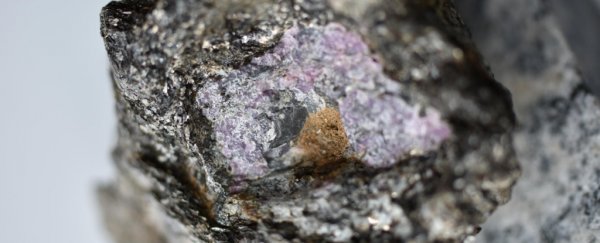A ruby that formed in Earth's crust 2.5 billion years ago encases evidence for early life, wriggling around in the planet's mud.
Trapped within the precious stone, geologists have identified residue of a form of pure carbon called graphite that, they say, is most likely biological in origin, the remains of some ancient microorganism from the time before multicellular life emerged on Earth.
"The graphite inside this ruby is really unique. It's the first time we've seen evidence of ancient life in ruby-bearing rocks," said geologist Chris Yakymchuk of the University of Waterloo in Canada.
"The presence of graphite also gives us more clues to determine how rubies formed at this location, something that is impossible to do directly based on a ruby's color and chemical composition."
Rubies are a variety of the mineral corundum – a crystalline form of aluminum oxide. It forms under intense heat and pressure at Earth's tectonic boundaries, where tectonic subduction and collision create the necessary environment. The stones are imbued with their deep hue by the presence of the rare element chromium – the more chromium, the redder the gem.
Like all minerals, rubies vary in purity and clarity. The formation processes can lead to the presence of impurities, or inclusions, in precious gems. That might make these stones unsuitable for jewelry, but it's fantastic for science.
For example, a mineral from thousands of kilometers below ground that wouldn't otherwise survive on the surface was found preserved in a diamond. Surface minerals found in another diamond that formed deep underground led to a better understanding of how tectonic subduction can slurp surface material downwards. (There was also a diamond in another diamond, but that's just cool.)
Yakymchuk and his team were seeking to better understand corundum formation processes by studying rubies in Greenland, where one of the world's oldest known deposits of the mineral is located. While studying these samples, they found the graphite inclusion.
Graphite can form abiotically, that is, through chemical and mineral processes; however, it can also be a significant biomarker. One way to discern the difference is by determining the carbon isotope, which are forms of the same element with different numbers of neutrons in the nuclei, and therefore different atomic masses.
Carbon-14, for instance, is the radiocarbon famously used for precise dating of physical artifacts; it forms abiotically in Earth's atmosphere. The lightest natural isotope of stable carbon on Earth is carbon-12, and it's this isotope that is found most abundantly on Earth, and that occurs in living organisms.
The team found that the graphite in the ruby was carbon-12, in abundances consistent with an organic origin. And, because we know the age of the gem, this allowed the researchers to narrow down what that organic origin could be, since life on Earth 2.5 billion years ago was extremely limited.
"Living matter preferentially consists of the lighter carbon atoms because they take less energy to incorporate into cells," Yakymchuk said.
"Based on the increased amount of carbon-12 in this graphite, we concluded that the carbon atoms were once ancient life, most likely dead microorganisms such as cyanobacteria."
This led to some clues as to how the rubies could have formed at all, too. Corundum doesn't form in environments that have too much silica.
The presence of graphite suggests the presence of fluid that would have helped transfer silicon dioxide out of the rock, priming the environment for the formation of corundum in the first place.
The research has been published in Ore Geology Reviews.
